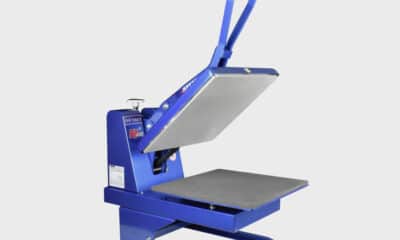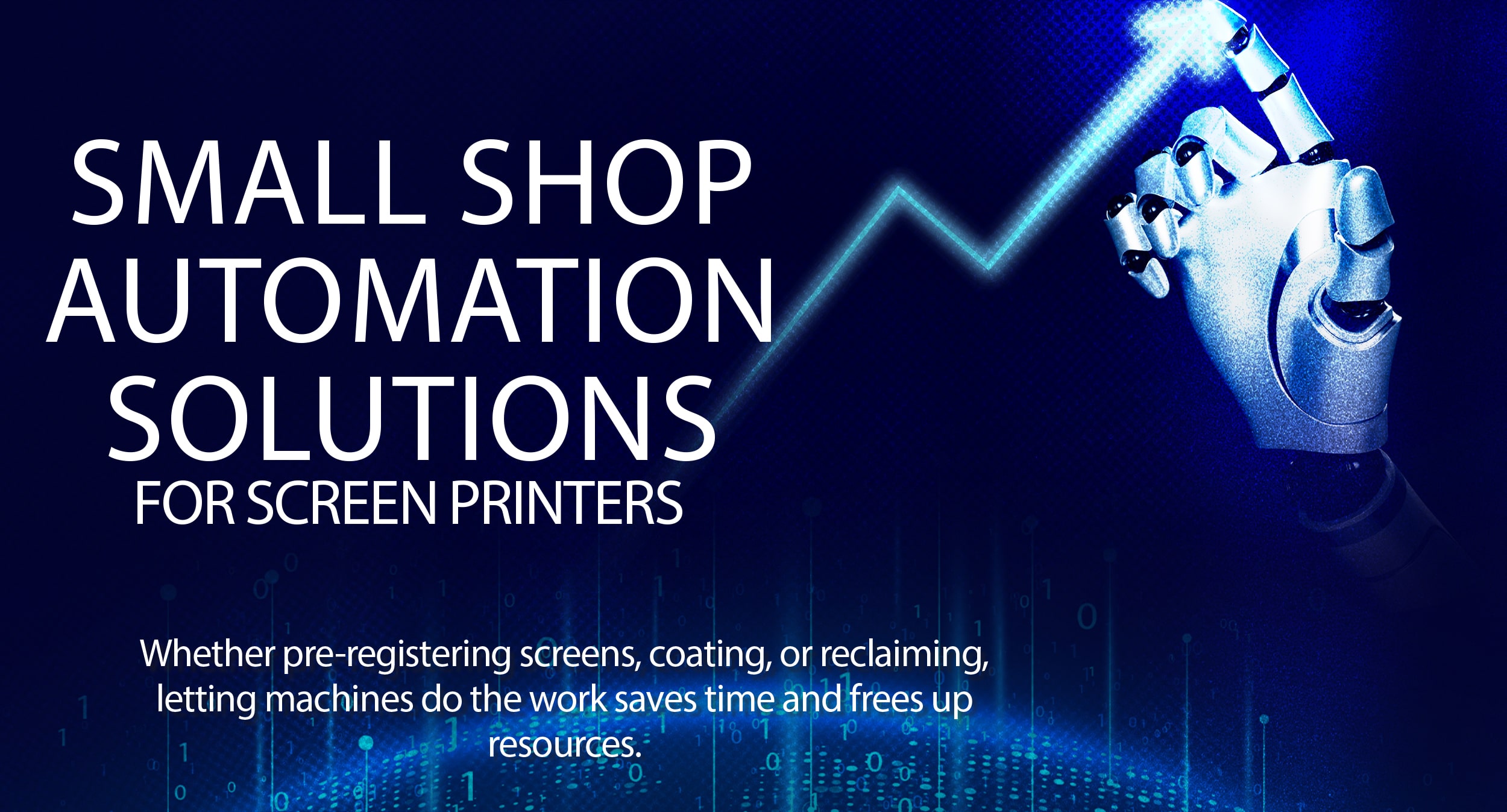
Published
3 months agoon
AUTOMATION IS ALL THE BUZZ for screen printers. This includes new presses, reclaiming equipment, imaging solutions, etc. And why not? With the labor pool being short and at a premium, you should be looking at this in all areas of your shop so you are working smarter not harder.
But what about small shops that may not have the room or resources for a $80,000 automatic reclaiming system, for instance? If you are a shop that is smaller and limited in resources, don’t worry. There are many options to automate or semi automate, and all without busting a budget. Of course, this requires investments in equipment and supplies, but with most cases you may already be paying for this in manual labor and not even know it.
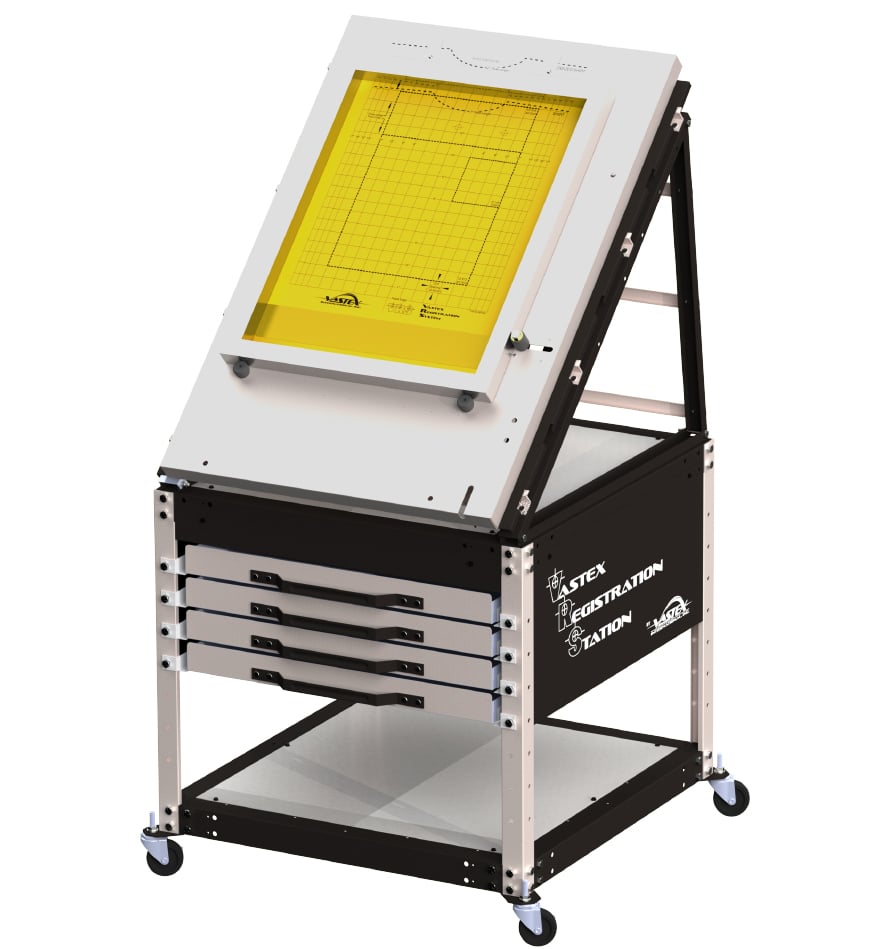
Pre-registration systems like this one from Vastex are not a new item to screen printers, but these time savers are a must for every shop. The savings are in time and production for a very minimal investment. They are available for manual and automatic presses.
THE STARTING POINT
Pre-registration systems are not a new item but may be overlooked. These time savers are a must for every shop. The savings are in time and production for a very small investment. These systems are available for manual and automatic presses. For nearly every machine made, you will have to implement an S.O.P (Standard Operating Procedure) for all employees. No exceptions and no excuses. Throw out the idea that they don’t work, or my seasoned employee is faster doing it manually, etc. No matter what it is, you must set the S.O.P. and implement it.
The most common pre-registration is a three-point system that works with your press, screens, and exposing. It makes everything standard, registers closer, and is faster in setup. It’s all about time. If it’s 15 minutes per color for registering (including squeegee, flood bar, ink in screen, test print and approval) and the pre reg reduces 3 minutes to 12 minutes a color on a four-color job, you have saved 3 minutes x 4 color = 12 minutes x 5 jobs a day. That means you have gained 60 minutes (1 hour per day) or five hours a week — over a half day of production! With this, you have received the gift of time. Time is money — more time printing and less time on setup.
Some thoughts: If you are using film, carrier sheets will need to be used. If you have a direct-to-screen (DTS) unit, then the pre-registration easily can be implemented. Also, if a screen is ripped during printing, just get the carrier sheet for that color, expose a new screen, and get it back on press. It has been registered quickly and you can get back to printing.
I am a huge believer in pre-registration systems. The only drawback is not using it. The S.O.P. must be implemented for all employees to use no matter what the skill level. This makes it a standard procedure; the screen printer who refuses because he says they don’t work and can tap it faster manually should be corrected. You must be the owner and implement it with an S.O.P. Change is difficult for humans, but necessary. Whether using a manual or automatic press, these are a must.
Advertisement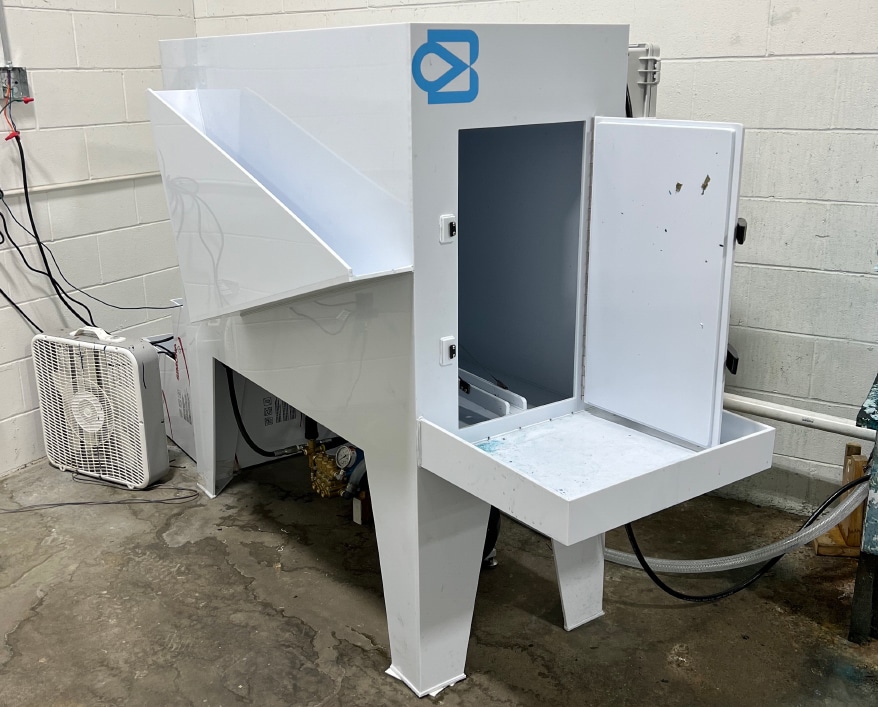
The Bluewater HP-1 from Easiway Systems is an example of a semi-automatic reclaiming system, which offers labor savings for a small investment. In fact, you already may be paying for current time and labor when the financial resources could be used to streamline and save money in the long run.
AUTOMATIC COATING SAVES TIME
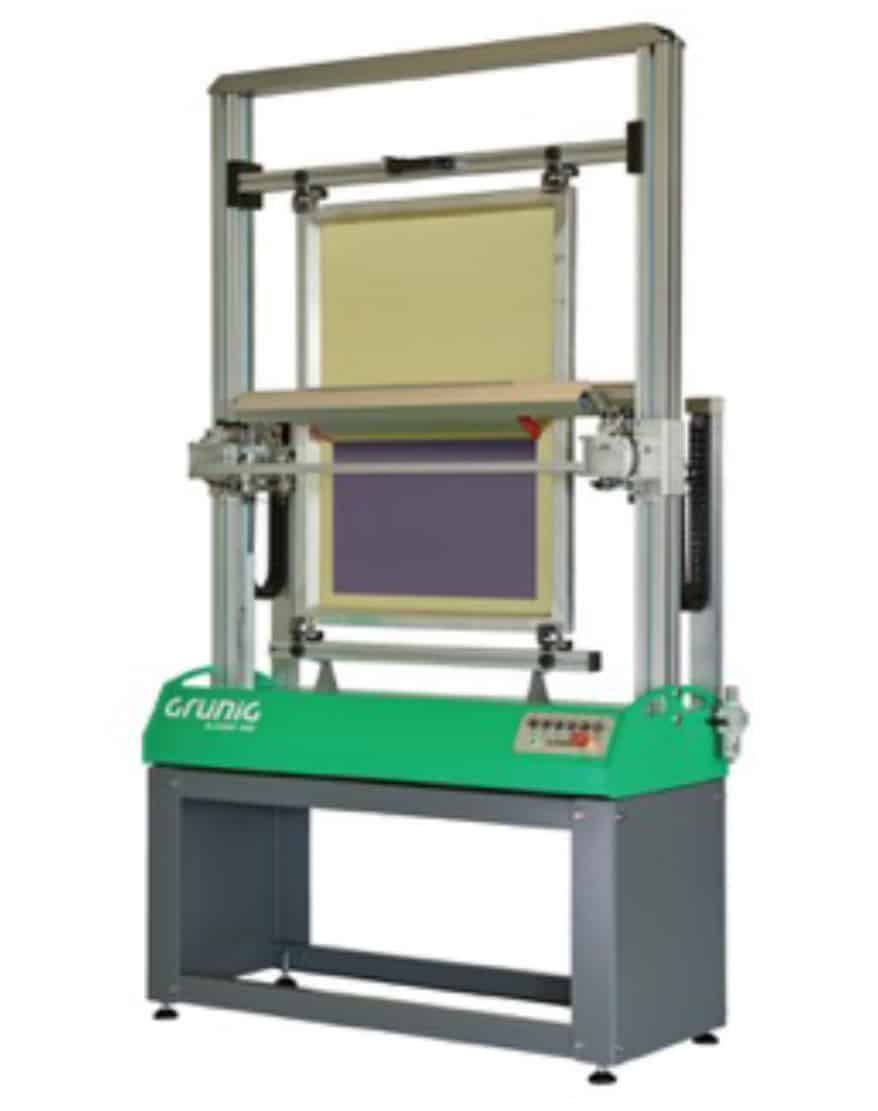
This Grunig automatic screen coater available from Kiwo comes in two sizes and features “plug and coat” construction. It provides for one- or double-sided simultaneous screen coating.
Auto coaters are not new, but most shops do not realize how affordable they may be and the advantages of having one. It’s not about how fast you can coat when using this equipment. It’s about consistency, labor, and working smarter, not harder.
As your screen is coating, either one at a time or two at a time depending on your machine, space and resources come into play. This is a time saver, as the screen is placed and locked in as the coating process starts.
The operator is not watching the machine but is multitasking doing other tasks such as exposing or developing a screen.
When the screen is done being coated, it is racked and a new screen is placed inside for coating. In small shops, I have seen that just one operator is coating screens, placing film on screens, or imaging with a DTS unit while the fresh screen is coating. Creating an S.O.P. of continual multitasking and time-saving duties while allowing anyone to coat means employee cross training is easier.
The auto coating machine is one that will save time and make your employees’ use of time more productive. For shop owners that I’ve worked with, once the machine is up and running, they say to me, “Why didn’t I do this sooner?!”
But even though the equipment is automated, that doesn’t mean some human interaction isn’t needed. For instance, you must keep the coating trough filled. Do not let it run low — this affects the coating thickness and consistency of each screen. Also important is to keep it clean. Wash out the trough and do not let emulsion dry on the edges.
Many of these machines can coat both sides of a screen at once and are able to be programmed for different coating methods for different mesh counts. These are added bonuses. And with many of them under $20,000, they can be a game changer.
FINISHING THE JOB
While auto reclaim machines are available and the value is very easy to justify, many full automated machines are too big, too cost prohibitive, and the three-phase electric needed can be an issue for the smaller shop. But at the time of this article’s publication, I do know of smaller footprint, fully automatic reclaiming machines that will be hitting the market soon. Importantly, these are available in single-phase electric so keep an eye out for what the market introduces in 2024.
If a fully automatic reclaiming system isn’t in your shop’s immediate future, there are semi-automated solutions currently on the market that work just as well. Again, this is a labor savings for a small investment that you may already be paying for in current time and labor. These machines take up very little room on your production floor and can create a solution that any employee can operate. This makes it advantageous for cross training employees.
Semi-automated reclaiming machines are what I like to call “pressure washers in a box”. The emulsion and ink are softened with a dip tank, and then removed with high-pressure water in the machine. A stain remover degreaser is then applied manually and put back into the machine to be high-pressure rinsed again.
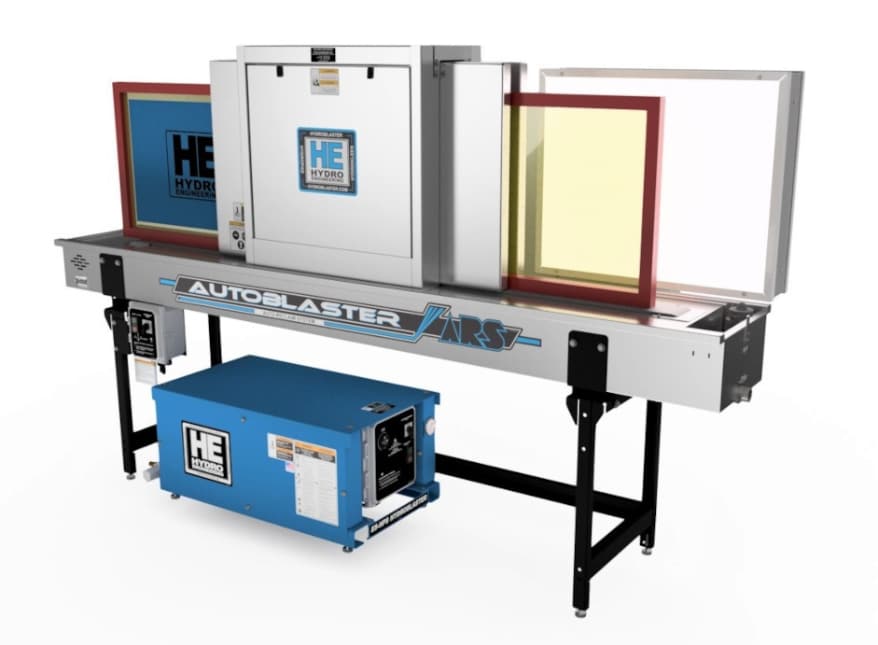
For this semi-automatic reclaiming machine, the Autoblaster/ARS design from Hydroblaster can provide a less labor intensive tool for reclaiming screens.
So there still are some labor steps but with the right S.O.P., reclaiming 15 to 20 screens an hour easily can be achieved and it makes the process easy for all employees. The cost can range from $20,000-$40,000.
Some of these machines are a conveyor style and may be loud and spit water, so make sure you have enough space in the room so that the sound or overspray is not an issue. Other models are contained, but both have about the same steps of labor. One thing: When buying, make sure the company is reputable and the machines are UL certified.
Remember, screen prep is important before reclaiming. Make sure there is minimal ink on the screen and remove any tape prior to starting. Also, proper exposure of the stencil is important for proper reclaim. This is because properly exposed stencils reclaim better than underexposed ones.
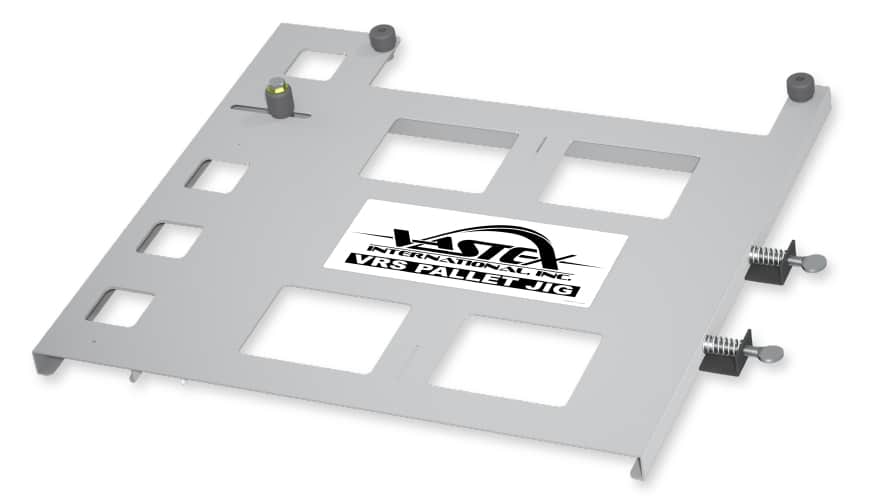
Pallet jigs like the VRS from Vastex are necessary for pre-registration systems to keep the screen locked in place during the registration process. This means more precise prints.
FINAL THINGS TO CONSIDER
Remember, as with any new machinery — especially automation of any kind — be prepared as the new process will magnify and expose where you are lacking and falling short in your current process. Don’t be discouraged. This is how changes are made and production and profitability are increased.
Automation machines do not have eyes; they just do what they do. So, having an S.O.P. is extremely important. Also, your shop’s service is crucial. What happens after the sale has value to the machine and your investment in it.
Everyone thinks they are an expert behind a keyboard or on an online forum, which can lead to lots of misleading information getting out there. Do your homework and research. Remember these are capital investments so keep them clean, updated, and have a maintenance schedule.
AdvertisementAlan Howe has 37 years of industry experience and is a Technical Sales Manager for Easiway Systems. Since 1987, he has held technical sales positions with well-known companies including Harco (now Brown Mfg.), Jay Products, Saati USA, and Tech Support SPS. As a seminar speaker with many articles published, he is a familiar face at trade shows and industry events. In 2018, he was inducted into the ASDPT; the Academy of Screen and Digital Print Technology.

SPONSORED VIDEO
Let’s Talk About It
Creating a More Diverse and Inclusive Screen Printing Industry
LET’S TALK About It: Part 3 discusses how four screen printers have employed people with disabilities, why you should consider doing the same, the resources that are available, and more. Watch the live webinar, held August 16, moderated by Adrienne Palmer, editor-in-chief, Screen Printing magazine, with panelists Ali Banholzer, Amber Massey, Ryan Moor, and Jed Seifert. The multi-part series is hosted exclusively by ROQ.US and U.N.I.T.E Together. Let’s Talk About It: Part 1 focused on Black, female screen printers and can be watched here; Part 2 focused on the LGBTQ+ community and can be watched here.
You may like
Advertisement

Atlantis Headwear Goes Solar for Sustainable Future

Comfort Colors Announces New Proprietary Dyeing Process Called “Pigment Pure”

10 Production Scheduling Secrets That Will Have Your Team Ready to Rock
Advertisement
Subscribe

Bulletins
Get the most important news and business ideas from Screen Printing magazine's news bulletin.
Advertisement
Most Popular
-

 Case Studies2 months ago
Case Studies2 months agoHigh-Density Inks Help Specialty Printing Take Center Stage
-

 Art, Ad, or Alchemy2 months ago
Art, Ad, or Alchemy2 months agoF&I Printing Is Everywhere!
-

 Andy MacDougall2 months ago
Andy MacDougall2 months agoFunctional and Industrial Printing is EVERYWHERE!
-

 Columns4 weeks ago
Columns4 weeks ago8 Marketing Mistakes Not to Make When Promoting Your Screen Printing Services Online
-

 Editor's Note3 weeks ago
Editor's Note3 weeks agoLivin’ the High Life
-

 Marshall Atkinson3 weeks ago
Marshall Atkinson3 weeks agoHow to Create a Winning Culture in Your Screen-Printing Business
-

 Thomas Trimingham2 months ago
Thomas Trimingham2 months ago“Magic” Marketing for Screen Printing Shops
-

 Case Studies4 weeks ago
Case Studies4 weeks agoScreen Printing for Texture and Depth
